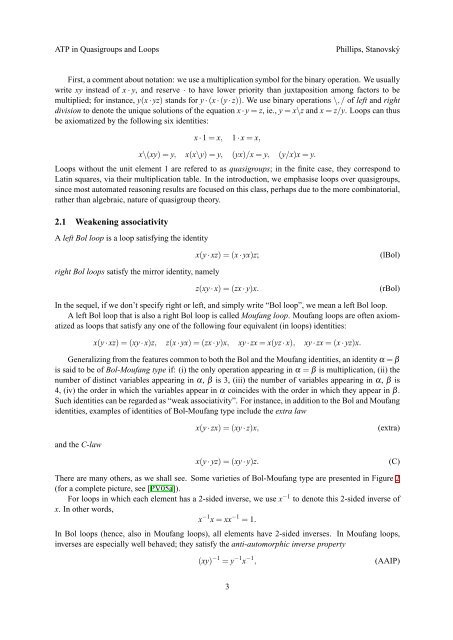Automated Theorem Proving in Quasigroup and Loop Theory
Automated Theorem Proving in Quasigroup and Loop Theory
Automated Theorem Proving in Quasigroup and Loop Theory
Create successful ePaper yourself
Turn your PDF publications into a flip-book with our unique Google optimized e-Paper software.
ATP <strong>in</strong> <strong>Quasigroup</strong>s <strong>and</strong> <strong>Loop</strong>s<br />
Phillips, Stanovský<br />
First, a comment about notation: we use a multiplication symbol for the b<strong>in</strong>ary operation. We usually<br />
write xy <strong>in</strong>stead of x · y, <strong>and</strong> reserve · to have lower priority than juxtaposition among factors to be<br />
multiplied; for <strong>in</strong>stance, y(x · yz) st<strong>and</strong>s for y · (x · (y · z)). We use b<strong>in</strong>ary operations \,/ of left <strong>and</strong> right<br />
division to denote the unique solutions of the equation x · y = z, ie., y = x\z <strong>and</strong> x = z/y. <strong>Loop</strong>s can thus<br />
be axiomatized by the follow<strong>in</strong>g six identities:<br />
x · 1 = x, 1 · x = x,<br />
x\(xy) = y, x(x\y) = y, (yx)/x = y, (y/x)x = y.<br />
<strong>Loop</strong>s without the unit element 1 are refered to as quasigroups; <strong>in</strong> the f<strong>in</strong>ite case, they correspond to<br />
Lat<strong>in</strong> squares, via their multiplication table. In the <strong>in</strong>troduction, we emphasise loops over quasigroups,<br />
s<strong>in</strong>ce most automated reason<strong>in</strong>g results are focused on this class, perhaps due to the more comb<strong>in</strong>atorial,<br />
rather than algebraic, nature of quasigroup theory.<br />
2.1 Weaken<strong>in</strong>g associativity<br />
A left Bol loop is a loop satisfy<strong>in</strong>g the identity<br />
x(y · xz) = (x · yx)z;<br />
(lBol)<br />
right Bol loops satisfy the mirror identity, namely<br />
z(xy · x) = (zx · y)x.<br />
(rBol)<br />
In the sequel, if we don’t specify right or left, <strong>and</strong> simply write “Bol loop”, we mean a left Bol loop.<br />
A left Bol loop that is also a right Bol loop is called Moufang loop. Moufang loops are often axiomatized<br />
as loops that satisfy any one of the follow<strong>in</strong>g four equivalent (<strong>in</strong> loops) identities:<br />
x(y · xz) = (xy · x)z, z(x · yx) = (zx · y)x, xy · zx = x(yz · x), xy · zx = (x · yz)x.<br />
Generaliz<strong>in</strong>g from the features common to both the Bol <strong>and</strong> the Moufang identities, an identity α = β<br />
is said to be of Bol-Moufang type if: (i) the only operation appear<strong>in</strong>g <strong>in</strong> α = β is multiplication, (ii) the<br />
number of dist<strong>in</strong>ct variables appear<strong>in</strong>g <strong>in</strong> α, β is 3, (iii) the number of variables appear<strong>in</strong>g <strong>in</strong> α, β is<br />
4, (iv) the order <strong>in</strong> which the variables appear <strong>in</strong> α co<strong>in</strong>cides with the order <strong>in</strong> which they appear <strong>in</strong> β.<br />
Such identities can be regarded as “weak associativity”. For <strong>in</strong>stance, <strong>in</strong> addition to the Bol <strong>and</strong> Moufang<br />
identities, examples of identities of Bol-Moufang type <strong>in</strong>clude the extra law<br />
x(y · zx) = (xy · z)x,<br />
(extra)<br />
<strong>and</strong> the C-law<br />
x(y · yz) = (xy · y)z.<br />
(C)<br />
There are many others, as we shall see. Some varieties of Bol-Moufang type are presented <strong>in</strong> Figure 2<br />
(for a complete picture, see [PV05a]).<br />
For loops <strong>in</strong> which each element has a 2-sided <strong>in</strong>verse, we use x −1 to denote this 2-sided <strong>in</strong>verse of<br />
x. In other words,<br />
x −1 x = xx −1 = 1.<br />
In Bol loops (hence, also <strong>in</strong> Moufang loops), all elements have 2-sided <strong>in</strong>verses. In Moufang loops,<br />
<strong>in</strong>verses are especially well behaved; they satisfy the anti-automorphic <strong>in</strong>verse property<br />
(xy) −1 = y −1 x −1 ,<br />
(AAIP)<br />
3
















